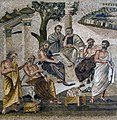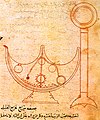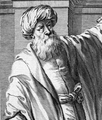Portal:History of science
The History of Science Portal
The history of science covers the development of science from ancient times to the present. It encompasses all three major branches of science: natural, social, and formal. Protoscience, early sciences, and natural philosophies such as alchemy and astrology during the Bronze Age, Iron Age, classical antiquity, and the Middle Ages declined during the early modern period after the establishment of formal disciplines of science in the Age of Enlightenment.
Science's earliest roots can be traced to Ancient Egypt and Mesopotamia around 3000 to 1200 BCE. These civilizations' contributions to mathematics, astronomy, and medicine influenced later Greek natural philosophy of classical antiquity, wherein formal attempts were made to provide explanations of events in the physical world based on natural causes. After the fall of the Western Roman Empire, knowledge of Greek conceptions of the world deteriorated in Latin-speaking Western Europe during the early centuries (400 to 1000 CE) of the Middle Ages, but continued to thrive in the Greek-speaking Byzantine Empire. Aided by translations of Greek texts, the Hellenistic worldview was preserved and absorbed into the Arabic-speaking Muslim world during the Islamic Golden Age. The recovery and assimilation of Greek works and Islamic inquiries into Western Europe from the 10th to 13th century revived the learning of natural philosophy in the West. Traditions of early science were also developed in ancient India and separately in ancient China, the Chinese model having influenced Vietnam, Korea and Japan before Western exploration. Among the Pre-Columbian peoples of Mesoamerica, the Zapotec civilization established their first known traditions of astronomy and mathematics for producing calendars, followed by other civilizations such as the Maya.
Natural philosophy was transformed during the Scientific Revolution in 16th- to 17th-century Europe, as new ideas and discoveries departed from previous Greek conceptions and traditions. The New Science that emerged was more mechanistic in its worldview, more integrated with mathematics, and more reliable and open as its knowledge was based on a newly defined scientific method. More "revolutions" in subsequent centuries soon followed. The chemical revolution of the 18th century, for instance, introduced new quantitative methods and measurements for chemistry. In the 19th century, new perspectives regarding the conservation of energy, age of Earth, and evolution came into focus. And in the 20th century, new discoveries in genetics and physics laid the foundations for new sub disciplines such as molecular biology and particle physics. Moreover, industrial and military concerns as well as the increasing complexity of new research endeavors ushered in the era of "big science," particularly after World War II. (Full article...)
Selected article -

Electrochemistry is the branch of physical chemistry concerned with the relationship between electrical potential difference and identifiable chemical change. These reactions involve electrons moving via an electronically conducting phase (typically an external electrical circuit, but not necessarily, as in electroless plating) between electrodes separated by an ionically conducting and electronically insulating electrolyte (or ionic species in a solution).
When a chemical reaction is driven by an electrical potential difference, as in electrolysis, or if a potential difference results from a chemical reaction as in an electric battery or fuel cell, it is called an electrochemical reaction. Unlike in other chemical reactions, in electrochemical reactions electrons are not transferred directly between atoms, ions, or molecules, but via the aforementioned electronically conducting circuit. This phenomenon is what distinguishes an electrochemical reaction from a conventional chemical reaction. (Full article...)
Selected image

Astronaut Buzz Aldrin, Apollo Lunar Module pilot, walks on the surface of the Moon near the leg of the Lunar Module Eagle during the Apollo 11 extravehicular activity (EVA). Astronaut Neil A. Armstrong, commander, took this photograph with a 70mm lunar surface camera. While astronauts Armstrong and Aldrin descended in the Eagle to explore the Sea of Tranquility region of the Moon, astronaut Michael Collins, command module pilot, remained with the Command and Service Module Columbia in lunar orbit.
Did you know
...that the word scientist was coined in 1833 by philosopher and historian of science William Whewell?
...that biogeography has its roots in investigations of the story of Noah's Ark?
...that the idea of the "Scientific Revolution" dates only to 1939, with the work of Alexandre Koyré?
Selected Biography -
Muhammad ibn al-Katib Sinan al-Qunawi (died c. 1524), also known as Muhammad ibn Yusuf, was an Ottoman astronomer and muwaqqit (timekeeper) in the late fifteenth and early sixteenth century. A pioneer of Ottoman astronomy, especially in the field of astronomical instruments and timekeeping, he served as muwaqqit at various mosques, and eventually at the Sublime Porte under Suleiman the Magnificent (r. 1520–1566). He was influenced by earlier Mamluk astronomers, especially Shams al-Din al-Khalili (1320–1380) and Ibn al-Shatir (c. 1304–1375), as well as by the Central Asian Ali al-Qushji and Al-Biruni.
He wrote two treatises on the construction of the astrolabe quadrant (al-rub' al-muqantarat), including Hadiyat al-Muluk ("A Present for Kings") dedicated to Bayezid II (r. 1481–1512). He published a Turkish edition of Al-Khalili's universal tables, and compiled Mizan al-Kawakib ("Balance of the Stars"), containing tables that allow reading the time at night by observing the stars—"the most original Ottoman contribution to astronomical timekeeping by tables" according to historian of astronomy David A. King. In addition to the then commonly used Arabic, he also wrote in Turkish, in order to make his field more accessible throughout the empire. This tradition would be continued by astronomers such as Mustafa ibn Ali al-Muwaqqit. Taha Yasin Arslan writes that al-Qunawi "single-handedly pioneered" the science of timekeeping in the Ottoman Empire. (Full article...)
Selected anniversaries
- 1496 - Leonardo da Vinci unsuccessfully tests a flying machine
- 1641 - Death of Jeremiah Horrocks, English astronomer (b. 1618)
- 1722 - Birth of Fredric Hasselquist, Swedish naturalist (d. 1752)
- 1810 - Birth of Antoine Thomson d'Abbadie, French geographer (d. 1897)
- 1819 - Birth of Charles Piazzi Smyth, Astronomer Royal for Scotland (d. 1900)
- 1888 - The refracting telescope at the Lick Observatory, measuring 91 cm in diameter, is used for the first time. It was the largest telescope in the world at the time
- 1927 - Death of Carle David Tolmé Runge, German physicist (b. 1856)
- 1957 - The Hamilton Watch Company introduces the first electric watch
- 1969 - Death of Jean Focas, Greco-French astronomer (b. 1909)
- 1989 - Death of Sergei Lvovich Sobolev, Russian mathematician (b. 1909)
Related portals
Topics
General images
Subcategories
Things you can do
Help out by participating in the History of Science Wikiproject (which also coordinates the histories of medicine, technology and philosophy of science) or join the discussion.
Associated Wikimedia
The following Wikimedia Foundation sister projects provide more on this subject:
-
Commons
Free media repository -
Wikibooks
Free textbooks and manuals -
Wikidata
Free knowledge base -
Wikinews
Free-content news -
Wikiquote
Collection of quotations -
Wikisource
Free-content library -
Wikiversity
Free learning tools -
Wiktionary
Dictionary and thesaurus









































































